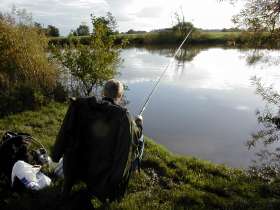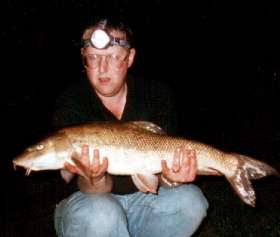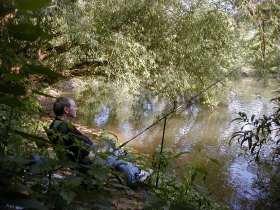|
|
| |
Dave will use heavy gear to fish for big barbel one day and a pole on ultra-light tackle the next to bag up on roach.
The emphasis on this series is how to enjoy your fishing no matter where you’re fishing or what you’re fishing for.
THE TWILIGHT ZONE
I don’t suppose I am much different to other people when it comesto fishing in that I like to get the maximum benefit out of the timeI spend on the bank. I am constantly on the lookout for ways andmeans of improving my catch rate and the quality of fish that Icatch. Despite fishing for well over 30 years now, I can honestlysay that I never stop learning.
Lessons can be small things
Mostly for me these days the lessons are small things, a new trickhere, a new method there, a new knot, a new presentation. For noviceanglers however, these lessons can be huge milestones in theirlearning, quite obvious and easy when someone explains, but prior tothat a mystery. One of the major milestones in my fishing, one thatgave me one of the biggest leaps forward In both numbers of fishcaught and the quality, was recognising when potentially was the besttime of day to catch quality fish.
|
|
| |
And one of the key times I have learned is that from this time ofyear forward until late on in the autumn, for the majority ofspecies, the most productive sessions by far are at the beginning andend of the day. This is obviously not something I discovered bymyself. It has long been known by far better anglers than me thatthese are key times. In fact it took me far too long to appreciatethe quality fishing I was missing by either still being in bed whilethe fish were having breakfast or just packing up and going home asthe fish were considering supper.
Fish, especially big fish, are cautious creatures. The world inwhich they live is, by comparison to ours, extremely harsh and cruel. In order to survive and become big, specimen fish have a naturaltendency to be wary, not venturing far from cover in the times offull daylight. They come out to feed or are prepared to feed in moreexposed areas when light levels have dropped and the predators areless active.
Autumn in Ireland
An autumn session in Ireland nearly 20 years ago, while breamfishing on the river Barrow, highlighted this to me in a significantmanner. A friend and I fished a shallow swim, about 4ft deep andjust off the main depth and current. We arrived at around 7:00am,more from keenness than design, as the first light of dawn wasencroaching on the horizon. In the next two hours we had 50lb offish each, a bite a chuck. Then at 9:00am the direct sunlight cameover the top of the far bank trees increasing the light levelsignificantly and the shoal just disappeared into the deeper waterdespite the amount of feed in our swim. If we had arrived at 9:00we wouldn’t have had a bite. Consequently we moved to deeper waterswims and continued to catch and the experience was duly noted in thefishing encyclopaedia inside my head.
Tench – the epitome of dawn feeders
Tench are the epitome of dawn feeders. The classic fizzing ofbubbles around the lily pads as they stand on their noses and grubaround in the silt is most often observed, and is certainly at it’smost intense, at first light and for the next couple of hours. Gradually the bubbling will die away as the tench go off the feed inresponse to the increasing light level. This does not mean thattench cannot be caught in full daylight, but they usually come fromdeeper water and most likely are not feeding heavily and sending up astream of those tell tale bubbles.
Nocturnal bream
The best chance of landing a specimen bream is after dark. Although the smaller shoal fish are quite obliging through thedaylight hours, if you want a reasonable chance of a double figurebream, then night time is when you should be fishing. You have to doeverything else right of course, by fishing a water that holds bigbream, work out the feeding patrol routes and baiting up accordinglywith copious quantities of feed. But the bites if they come will moreoften than not be in the dark hours, not daylight.
|
|
| Note the headtorch for practical use and safety |
Last hour for barbel
Barbel are classic evening feeders. During the summer months thelast hour of daylight and the first of darkness is when I sit quietlyin the swim and almost expect the rod tip to pull violently round. This is especially true of bigger fish. Shoal barbel, up to sixpounds or so, will prove very co-operative at times during the daybut if I want a bigger fish then I will be fishing hard at dusk andinto the night. Big barbel can be caught throughout the night infact and many a good fish has been caught well past midnight, but myfavourite time, when that feeling of tense expectation is at itshighest, is around dusk. Again, the right preparation is essentialwhen targeting barbel after dark as you need to arrive several hoursearlier and prepare potential swims. Baiting up with hemp, corn andhook bait samples and then leaving well alone for a few hours priorto fishing can increase your chances of a good fish big time.
First light for perch
Large perch also respond to light levels, but slightly differentlyto other species I have found. Being predators they rely heavily onsight so are rarely caught after dark. But first light is still agood time to catch a large specimen if you know where they are to befound, which is generally harassing the small shoals of fry orminnows in the shallower water. As the morning progresses and thelight levels increase they will generally move to deeper water and,providing there is sufficient cloud cover, I would be confident ofcatching them throughout the day. And then the last couple of hoursof daylight can be very good too. Some of my best perch have come atthis time, but as soon as the light level drops below a certainpoint, certainly well before full dark, they switch off.
Roach in twilight
|
|
| |
Other species also respond to the darker hours. Big roach can beencountered at twilight and through the night and big eels aredefinitely nocturnal feeders, responding best to small dead baits andlobworms.
Dusk and dawn for chub
Specimen chub often feed more freely at dusk and dawn, being lesswary than in the daylight and willing to venture from their daytimecover.
Cats like darkness
Catfish, becoming more popular these days and found in everincreasing numbers of stillwaters, are generally night feeders. Inmy opinion night time should most definitely be given a go if you areafter a specimen of most species.
But a word of caution
|
|
| yourself, says Dave |
If this has whetted your appetite for a session into darkness, aword of caution to those who have not night fished before. Nightfishing is not something that you should do on the spur of themoment. You need to be prepared, think carefully about where youfish and be organised. You must have the right equipment, especiallya good torch, preferably a head torch that leaves both hands free. Be familiar with the swim or swims you are going to fish as theyappear very different after dark and it is essential that you treatthe bank with respect. One false move in the dark and you could beup to your neck in water, disoriented and not able to see. That isnot a desirable scenario.
Make sure you have adequate clothing as the nights can getdeceptively cold next to the waters edge even in summer and youshould also give consideration to shelter in case of rain. Keepeverything as simple as possible and close to hand. If you can avoidscrambling about in the dark looking for items of tackle, do so. Ifpossible don’t fish alone, certainly not on rivers if you are notused to it.
For the prepared angler though, the dark hours and first and lastlight of the day can be the time for encountering dream fish. Sodon’t lounge about in your beds, get into the twilight zone and getthose specimens in the net.















